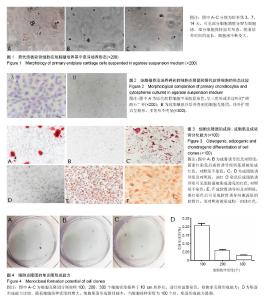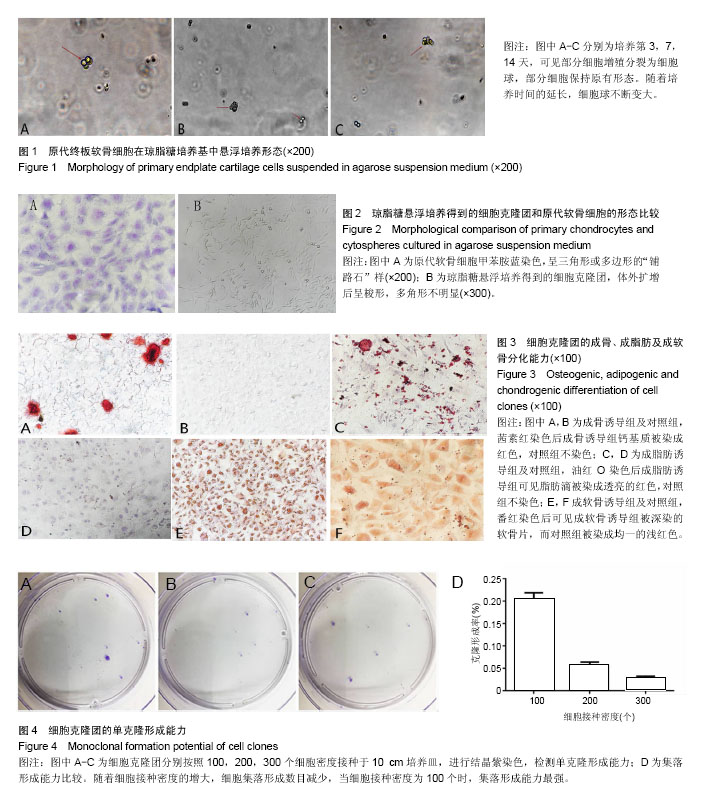| [1] Freemont AJ. The cellular pathobiology of the degenerate intervertebral disc and discogenic back pain. Rheumatology (Oxford). 2009;48(1):5-10.[2] Xu HG, Zheng Q, Song JX, et al. Intermittent cyclic mechanical tension promotes endplate cartilage degeneration via canonical Wnt signaling pathway and E-cadherin/ β-catenin complex cross-talk. Osteoarthritis Cartilage. 2016; 24(1):158-168.[3] Xu HG, Ma MM, Zheng Q, et al. P120-Catenin Protects Endplate Chondrocytes From Intermittent Cyclic Mechanical Tension Induced Degeneration by Inhibiting the Expression of RhoA/ROCK-1 Signaling Pathway. Spine (Phila Pa 1976). 2016;41(16):1261-1271.[4] Huang D, Zhao Q, Liu H, et al. PPAR-α Agonist WY-14643 Inhibits LPS-Induced Inflammation in Synovial Fibroblasts via NF-kB Pathway. J Mol Neurosci. 2016;59(4):544-553.[5] 俞莉敏. 联合应用基因工程与组织工程技术诱导裸鼠脊柱异位成骨的实验研究[D]. 苏州:苏州大学,2004.[6] 靳超,亓建洪. 干细胞构建软骨组织工程研究进展[J]. 中国矫形外科杂志,2015,23(12):1099-1103.[7] 王彦超,席志鹏,谢林. 细胞疗法是修复退变椎间盘最有前景的技术[J]. 中国组织工程研究,2017,21(20): 3234-3240.[8] Ghosh P, Moore R, Vernon-Roberts B, et al. Immunoselected STRO-3+ mesenchymal precursor cells and restoration of the extracellular matrix of degenerate intervertebral discs. J Neurosurg Spine. 2012;16(5):479-488.[9] Miyamoto T, Muneta T, Tabuchi T, et al. Intradiscal transplantation of synovial mesenchymal stem cells prevents intervertebral disc degeneration through suppression of matrix metalloproteinase-related genes in nucleus pulposus cells in rabbits. Arthritis Res Ther. 2010;12(6):R206.[10] Mello MA, Tuan RS. High density micromass cultures of embryonic limb bud mesenchymal cells: an in vitro model of endochondral skeletal development. In Vitro Cell Dev Biol Anim. 1999;35(5):262-269.[11] Sekiya I, Larson BL, Smith JR, et al. Expansion of human adult stem cells from bone marrow stroma: conditions that maximize the yields of early progenitors and evaluate their quality. Stem Cells. 2002;20(6):530-541.[12] Minguell JJ, Erices A, Conget P. Mesenchymal stem cells. Exp Biol Med (Maywood). 2001;226(6):507-520.[13] Buschmann MD, Gluzband YA, Grodzinsky AJ, et al. Chondrocytes in agarose culture synthesize a mechanically functional extracellular matrix. J Orthop Res. 1992;10(6): 745-758.[14] Buschmann MD, Gluzband YA, Grodzinsky AJ, et al. Mechanical compression modulates matrix biosynthesis in chondrocyte/agarose culture. J Cell Sci. 1995;108(Pt 4): 1497-1508.[15] Thornemo M, Tallheden T, Sjogren Jansson E, et al. Clonal populations of chondrocytes with progenitor properties identified within human articular cartilage. Cells Tissues Organs. 2005;180(3):141-150.[16] Benya PD, Shaffer JD. Dedifferentiated chondrocytes reexpress the differentiated collagen phenotype when cultured in agarose gels. Cell. 1982;30(1):215-224.[17] Wang H, Zhou Y, Huang B, et al. Utilization of stem cells in alginate for nucleus pulposus tissue engineering. Tissue Eng Part A. 2014;20(5-6):908-920.[18] Risbud MV, Guttapalli A, Tsai TT, et al. Evidence for skeletal progenitor cells in the degenerate human intervertebral disc. Spine (Phila Pa 1976). 2007;32(23):2537-2544.[19] Alhadlaq A, Mao JJ. Mesenchymal stem cells: isolation and therapeutics. Stem Cells Dev. 2004;13(4):436-448.[20] Bartold PM, Gronthos S. Standardization of Criteria Defining Periodontal Ligament Stem Cells. J Dent Res. 2017;96(5): 487-490.[21] 姚旺林,刘理金,徐训安,等. 损伤软骨的细胞提取、鉴定及生物学活性研究[J]. 中国现代医学杂志,2017,27(23):18-22.[22] Dominici M, Le Blanc K, Mueller I, et al. Minimal criteria for defining multipotent mesenchymal stromal cells. The International Society for Cellular Therapy position statement. Cytotherapy. 2006;8(4):315-317.[23] 郝飞,张玲,吴岩. 表皮干细胞的生物学标记物[J].中国组织工程研究, 2013,17(36):6527-6532.[24] 杨芬,杨乃龙. 胰岛干细胞来源及诱导分化与分子标记物[J]. 中国组织工程研究与临床康复,2007,11(7):1333-1336.[25] 宾志文,陈丽霞. 小鼠毛囊来源间充质干细胞体外诱导成软骨的细胞标记物[J]. 中国组织工程研究,2012,16(32):5973-5977.[26] 潘宏信,陈振光. 肺干细胞标记物的研究与进展[J]. 中国组织工程研究与临床康复, 2008,12(47):9347-9350. |

